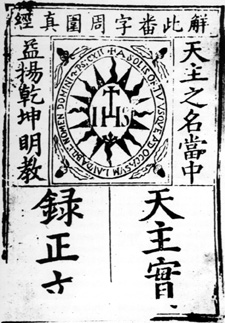 Frontispiece of an engraved book by Father Miguel Ruggiere, Society of Jesus, printed in Macau in 1585. This was the first book to be printed in Macau.
(Archives of the Society of Jesus in Rome; reproduction from Primórdios da Imprensa em Macau by Jack M. Braga, published in the Boletim Eclesiástico da Diocese de Macau, 1965.)
Frontispiece of an engraved book by Father Miguel Ruggiere, Society of Jesus, printed in Macau in 1585. This was the first book to be printed in Macau.
(Archives of the Society of Jesus in Rome; reproduction from Primórdios da Imprensa em Macau by Jack M. Braga, published in the Boletim Eclesiástico da Diocese de Macau, 1965.)
Because of its location as the centre of European trade in the Far East, because it was a stopping place for missionaries, ambassadors, merchants and travellers who came to this part of the globe and because of its numerous churches, convents, schools and its university, Macau was in a position to have the best library and most valuable documents in this part of Asia. Unfortunately, this is not the case and, quite the opposite, there are few documents dating from before the 18th century to be found in the libraries and archives. As for books, as far as is known, there are no more than sixteen books from the 17th century and twenty eight from the 18th century.
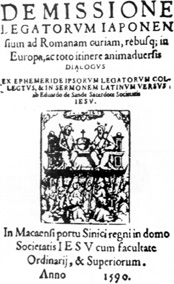 One of the first books to be printed in Macau - a description of the journey of the mission sent by the Japanese to Pope Gregory XIII, compiled by Father Alessandro Valignano and written in Latin by Father Duarte Sande, Society of Jesus. (Reproduction from Primórdios da Imprensa em Macau by Jack M. Braga.)
One of the first books to be printed in Macau - a description of the journey of the mission sent by the Japanese to Pope Gregory XIII, compiled by Father Alessandro Valignano and written in Latin by Father Duarte Sande, Society of Jesus. (Reproduction from Primórdios da Imprensa em Macau by Jack M. Braga.)
The National Library in the Leal Senado at present has only three books from the 17th century, a few from the 18th century. The bulk of its collection consists of books from the 19th and 20th centuries.
The private libraries such as those of Commander Lourenço Marques, Montalto de Jesus and José Baptista de Miranda e Lima have either disappeared or been greatly reduced in size. There remain only a few books from Jack M. Braga's library which were held in the Department of Chinese Affairs before being passed on to the National Library. Most of his collection was apparently sold to the University of Melbourne. The library of the Clube de Macau which included a complete collection of the old Macanese newspaper "A Abelha da China" and a valuable collection of newspapers and pamphlets printed in Portuguese in the East which had been made by Rafael das Dores disappeared without trace. This was also the fate of the libraries and archives of public and religious organizations.
On the 3rd of December, 1966, a third of the manuscripts of the archives of the Leal Senado were destroyed in a fire. The archives of the Ecclesiastical Chamber also ran to ruin over the years. All the old possessions of the archives of the Government Secretariat were lost in a flood in the typhoon of 1847.
Macau should have been a repository of documents which would have attested to the presence and influence of the Portuguese in the Far East but most of the documentation of historical value has been lost due to negligence, inclement weather and transfer to other parts of the Portuguese empire. The latter was the case with documents prior to the separation of Macau from Portuguese India in 1884. Those which were considered valuable were taken to the Archives of Goa and the rest were gradually taken back to Lisbon. In the end many of them were lost because of the lack of any organization which might have sought the preservation of documents relating to the Portuguese overseas interests.
As an example of this it is worth mentioning what happened to the documents which Commander Lourenço Marques sent to Lisbon in the last century. In 1851 or 1852, the Government of Macau wanted someone in Lisbon to write the history of the colony. Commander Lourenço Marques, who was at that time owner of the Gruta de Camões, filled three trunks with all the old documents on the history of Macau, some of which dealt with the poet Luís de Camões, which he had in his possession. He handed them over to the Governor of Macau who, because of their extreme importance to the history of the Portuguese colonies in the Far East, lost no time in sending them to Lisbon.
Years went by and no book appeared. Nor were the documents published. Commander Lourenço Marques, who owned the documents, requested that, as they were not being used, they should be returned to him. The reply came that the documents in their respective trunks had all gone missing.
Much later, in a letter to the President of the Leal Senado dated the 10th of July, 1883, José Alberto Corte Real, Secretary-General to the Government of Macau, wrote the following: "In Lisbon there must be valuable documents, some of which were purchased by the Naval Ministry in 1875, which belonged to the Library of José Torres. I am not certain whether they were included in the documents which were sent to Lisbon by Commander Lourenço Marques, on the fate of which there is still no information".
This is a general outline of what has happened to Macau's documents. It is now worth making a concrete examination of the present situation, in other words looking at the National Library of Macau and the Historical Archives of Macau, now the guardians of what wealth has been salvaged. However, as an example of what can happen with neglect, infestations of termites and bad weather, I shall start by discussing the fate of two important libraries in Macau which have been lost without any record, much for the worse of our already dilapidated cultural heritage. They are the libraries of the Seminário de S. Paulo and of the Clube Militar de Macau.
THE LIBRARY OF THE SEMINÁRIO DE S. PAULO
The Jesuits had a very early start in Macau and, given their interest in education and religion, they soon acquired a house next to the old church with an aim to instruct the pagans and to educate the Portuguese youngsters. By 1594 this house had already been prepared as a seminary where ninety children of residents in Macau would receive lessons. Later a college was founded where Latin, Theology, Philosophy and Fine Arts were taught.
In addition to the books which they brought from Europe and even India, the Jesuits introduced printing to Macau thus enabling them to print their own books. Father Alessandro Valignano (1539-1606) (1), the Jesuit's inspector in the East, understood the importance of printing in making the written word and, consequently, education and religion more accessible in the Far East, most of all in Japan. With this in mind he ordered the necessary equipment from Rome and installed a printing press in the old Cipango.
It was on Valignano's suggestion that the Japanese ambassadorial mission to Rome (2) in 1582 brought the printing equipment to Macau on their return home. In 1590 the equipment was taken to Japan where it was used for twenty three years.
In 1614, due to the persecution of Christians in Japan the unwieldy equipment was taken to Macau once more. It was later sold and remained in the home of André Botto and Manuel Ovello until 1620 (3). A short time later it was sold to the Augustinian order in Manila (4).
 Arte Breve da Lingoa Japoa (A Brief Introduction to Japanese), by Father João Rodrigues, printed in Macau in 1620.
(Edition from the Biblioteca da Ajuda in Primórdios da Imprensa em Macau by Jack M. Braga.)
Arte Breve da Lingoa Japoa (A Brief Introduction to Japanese), by Father João Rodrigues, printed in Macau in 1620.
(Edition from the Biblioteca da Ajuda in Primórdios da Imprensa em Macau by Jack M. Braga.)
The first book to be printed in Valignano's press in Macau was no more than a reprint of a work on Christian education edited by Father Giovani Bonifacio, Company of Jesuits (5) titled Cristiani Pueri Institutio, Adolescentiaequi Perfugium (...) in Portu Macaensi: in Domo Societatis Iesu: Anno 1588. It is two hundred and fifty two pages long and the only existing copy is in the library of the Palácio da Ajuda in Lisbon. (6)
The second book to be printed was about the journey which the Japanese Catholics made to Europe. It was written by the Portuguese Jesuit Eduardo de Sande and was titled De Missione Legatorum Iaponensium ad Romanam curiam, rebusq; in Europa (...) In Macaensi portu Sinici regni in domo Societatis Iesu (...) Anno 1590 (7). There are only twelve existing copies of this book. It describes the first Japanese missions to Rome in 1582-1585. As was mentioned, the Jesuits' printing press was in Japan from 1590 until 1614. In 1620 another book was printed in Macau called Arte Breve da Lingoa Iapoa Tirada da Arte Grande da Mesma lingoa, pera os que Começam a Aprender os Primeiros Princípios della (...) Em Amacao no Collegio da Madre de Deos da Companhia de Iesu. Anno MDCXX in 4, 4ff., nc. ff. (8).
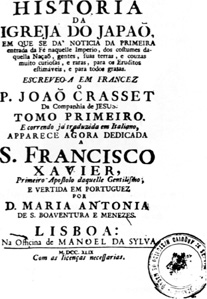 História da Igreja do Japão (History of the Church in Japan) by Father João Crasset, Society of Jesus (Manoel da Sylva, Lisbon, 1749).
A description of the first missionary work in Japan, translated into Portuguese by D. Maria Antónia de S. Boaventura e Menezes.
História da Igreja do Japão (History of the Church in Japan) by Father João Crasset, Society of Jesus (Manoel da Sylva, Lisbon, 1749).
A description of the first missionary work in Japan, translated into Portuguese by D. Maria Antónia de S. Boaventura e Menezes.
It is known that the last book to be printed in the Jesuit's printing press in Macau was a study on Japanese grammar by Father João Rodrigues a remarkable linguist who was called "Tsuyaku" ("Interpreter") by the Japanese (9). With their own printing press and the books which gradually began to appear in these parts, the library of the Colégio de S. Paulo grew until it became, along with that of Goa, one of the richest western libraries in the Far East.
João Álvares, an inhabitant of Macau, wrote in 1746 that the library of the Colégio de S. Paulo consisted of four thousand, two hundred books (10) and was situated in a large hall in the seminary (11).
As well as the library there were extensive archives which were copied by João Álvares and of which there are copies in the National Library in Lisbon, the Overseas Historical Archives and the "Jesuits in Asia" Department of the Ajuda Library.
By the time echoes of the Marquês de Pombal's persecution of the Jesuits began to reach Macau, Brother João Álvares had already patiently copied all the existing documents in the Colégio. He parceled them and sent them to Manila from where they were ultimately sent to Madrid. His action was a stroke of fortune for, had he not done this, the precious documents would have perished in the fire which destroyed the church of S. Paulo in 1835.
THE LIBRARY OF THE CLUBE MILITAR DE MACAU
Clube Militar (Military Club) is a more recent name for what was the Grémio de Macau (Guild of Macau), founded in Macau in April, 1870, by Second Lieutenant Rafael das Dores, Captain Manuel Azevedo Coutinho and Lieutenant Henrique de Carvalho.
As is obvious from the foundation of the Guild, the main objective was to establish "a library of military, technical and any other books..." (12). Once the statutes had been drawn up they were approved by the Government on the 24th of January, 1871, and were published on the 31st of the same month in the "Boletim de Macau e Timor". Article 3 stated that "the aim of the Society is to obtain both Portuguese and foreign books on military, naval, historical, technical and any other matters which are useful. In addition to this, members will be able to read newspapers and to play all games which are permitted by law. This will all contribute to the instruction and entertainment of the said members".
The library was improved with various additions and later on it acquired some precious bibliographic specimens such as first editions of the works of Camilo Castelo Branco, Eça de Queirós, Ramalho Ortigão, Guerra Junqueiro and many others.
Rafael das Dores lived for twenty five years in Macau and while he was here he managed to gather together an almost complete collection of all the newspapers published in Portuguese in the East. He also collected nearly one hundred pamphlets in Portuguese which had been published in various parts of China and Japan. Strangely enough, Rafael das Dores gave this collection to the Clube União (D. Pedro V Theatre) and not to the library of which he was the founder. In a general assembly of the Clube União a vote of praise and thanks to Major Rafael das Dores was proposed by Pedro Nolasco da Silva and at the same time he was made an honorary member of the club's library (13).
Nowadays nothing is known about the collection of newspapers which Rafael das Dores gave to the D. Pedro V Theatre and little remains of the books from his library.
As for the library of the Clube Militar, Father Manuel Teixeira says that in the fifties "the club needed a dance hall and the books took up too much space" (14). The newspaper "O Progresso" also makes the same point on the 2nd of November, 1952, publishing the news that the library had been shut for building work to make the walls "the same as those in the hall". The books were subjected to a selection process and those which were saved were handed over to the library of the military headquarters. The others were destroyed because they were damaged by termites. This marked the passing of the library of the Clube Militar de Macau.
THE NATIONAL LIBRARY OF MACAU
In 1873, the Governor of the Province of Macau and Timor, Visconde de S. Januário approved the statutes of the society named the Biblioteca Macaense (Library of Macau). The aim of the association was to establish and maintain a private library of Portuguese and foreign books which would instruct and entertain the members and subscribers. There were twenty owner-members administered by a committee composed of distinguished members of Macanese society of that time: Pedro Nolasco da Silva Jr., president; Domingos C. Pacheco, treasurer; Nicásio Simão, secretary; A. Bastos Jr. and Câncio Jorge, members. (15)
The committee was completely responsible for the acquisition of books and also for the allocation of the association's funds which consisted of a monthly contribution of one Pataca from each member, donations and other sources of finance.
Some years later the need for a public library was felt in Macau as the facilities offered by the Biblioteca Macaense were only available to members and were not within the economic reach of most of the citizens of Macau. Father Manuel Teixeira claims that the library disappeared without trace (16) but, although it is not definite, it seems that the documents were transferred to a new library which was established in Macau at that time. On the 29th of September, 1895, the government of Horta e Costa elected a committee of teachers (17) to establish the outlines for a public library for Macau. The first librarian was Matheus António de Lima, a well known figure in the cultural sphere of the period. After four years the statistics showed that there were thirty six readers and forty four books had been consulted. The areas of greatest interest were literature (fourteen books consulted), linguistics (ten books consulted), history (eight), botany (six) and mathematics (six). The opening hours were from eight in the morning until five in the afternoon (18).
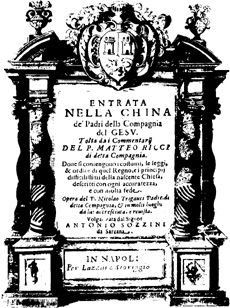 Entrata nella China de Padri della Compagnia del Gesu (Journey into China by Fathers of the Society of Jesus) by Father Nicolao Trigauci (Antonio Sozzini da Sarzana, Naples, 1615).
A report on the commencement of evangelization in China with commentaries by Father Mateus Ricci.
Entrata nella China de Padri della Compagnia del Gesu (Journey into China by Fathers of the Society of Jesus) by Father Nicolao Trigauci (Antonio Sozzini da Sarzana, Naples, 1615).
A report on the commencement of evangelization in China with commentaries by Father Mateus Ricci.
Once the library was set up, there was a wait of several years for the regulations of the Public Library of Macau to appear. This occured in September of1939. They were reformulated in April, 1945. In June, 1952, in accordance with the wishes of the administrating committee, the Overseas Ministry granted the Public Library of Macau the right enjoyed by other national libraries to function as a "legal depository". The Library was now called the National Library of Macau and its assets were improved with new acquisitions. Most of this was due to the fact that the library now regularly received new publications from publishing houses which were obliged by law to send a certain number of copies of each new book which came off the press. Hence by 1962 the National Library, situated in the Leal Senado building, had a collection of over forty three thousand books. The head librarian was Luís Gonzaga Gomes, an outstanding Macanese intellectual (19). Two years later the Library had over sixty thousand books and was in receipt of an average of one thousand books per month in its function as a "legal depository". At this time, the library of the former government Department of Chinese Affairs was absorbed into the National Library, thus improving the prestige of the latter (20).
During that year, Luís Gonzaga Gomes began the task of binding some of the works as well as the numerous collections of newspapers and magazines which had been published in an attempt to make them more accessible for researchers.
In 1966, Luís Gonzaga Gomes represented the National Library of Macau in the Second Conference of Portuguese Librarians and Archivists. During this conference in Lisbon the National Library of Macau was cited as an example of "a real testimony, not just of the preservation of part of the documental heritage of the country but also of its beneficial use in historical research and cultural evaluation of the people (...)" (21).
With a constantly increasing stock it became necessary to create an extension for some of the documents in the ground floor of the "Sir Robert Ho Tung" Cultural Centre.
Almost twenty years later the Director of Education, Dr. Peres Claro, invited Professor Silva Rego to come to Macau from September to December of 1980 in order to organize the extensive documentation which was in a state of semi-abandon in the National Library department on the ground floor of the Cultural Centre. The first task was to tidy up ancient documents which were virtually piled up in one of the rooms. The fourteen large boxes of books and newspapers there were kept locked up until such time as there was space to arrange them. After the existing bookcases had been arranged, two more cases were bought and the boxes were opened and provisionally organized. According to Professor Silva Rego, at that point there was not enough time to give the books professional restoration (22).
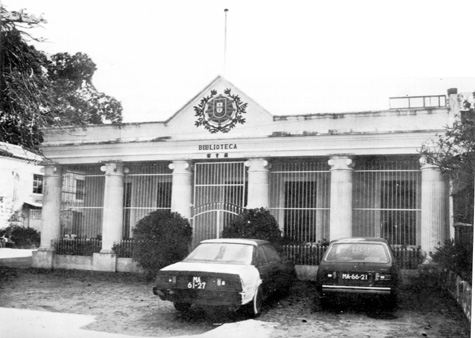
Coloane Library
On the 28th of October, 1983, Governor Almeida e Costa opened the new library building situated on the Avenida Conselheiro Ferreira de Almeida. It was one of a group of buildings which the government had ordered to be renovated. The outside was restored to its original appearance but the interior was completely renovated according to a modern functional design. The new head librarian in charge of the renovation was Dra. Maria de Graça Jácome. At present there are two main sections in the National Library of Macau: one for Portuguese speakers with printed matter in other western languages such as French, English, German etc,; the other is aimed at Chinese speakers.
The first section is divided into two parts which are:
1. The National Library (Headquarters). This building, situated on the Avenida Conselheiro Ferreira de Almeida, offers full lending library services for books published after 1952 from the legal depository. In the same building there is a Children's Reading Room and Library, a Special Collection where valuable books are kept and, finally, the Macau Room.
The Macau Room consists of a collection of books relating to Macau and the Portuguese presence in the East and a work room where a specialist in documental sciences restores the documents. One of the main tasks is to re-edit and bring up to date the Bibliografia Macaense written by the remarkable Macanese bibliographer, Luís Gonzaga Gomes. It is a reference work for around one and a half thousand monographs and three hundred periodicals which are in the Macau Room in the National Library and the annexed library in the Historical Archives of Macau.
The quarterly publication of the Boletim da Bibliografia Macaense is planned. It will consist of normal size, detachable index cards which can be filed in card indices.
2. The National Library (Leal Senado). This library has a stock of documents which are principally of historical interest. There are almost sixty thousand items including editions of exceptional bibliographic value such as Regni Chinensis Descriptio from 1639; the Nobiliário do Conde D. Pedro from 1640, the year of the restoration of the monarchy; the Cartas de Santa Teresa do Menino Jesus from 1678-1692 and the Crónica de D. João III from 1786.
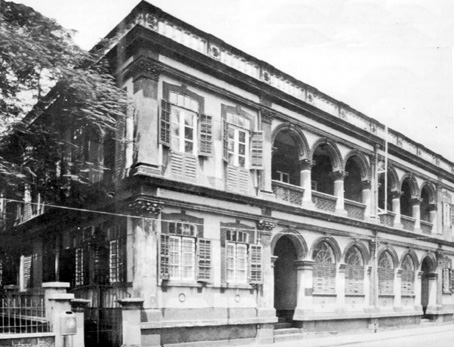
The National Library of Macau
The Library in the Leal Senado shut for three years from 1983 until 1986 while work was done on the building. The stock is now distributed between two different sections: one, fitted out with modern furniture, contains newspapers, overseas legislation, old Portuguese legislation and reference works; the second consists of two rooms which are called the "salas joaninas" because their furniture (23) is stylistically similar (D. João III) to that of the Library in the University of Coimbra (24). They have works on Portuguese, English and French literature, Portuguese history, Eastern culture and history, philosophy, art, etc., most of which are classical works.
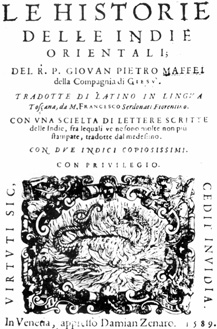
Le Historie delle Indie Orientali (A History of the East Indies) by Father Giovan Pietro Maffei (Damian Zenaro, Venice, 1589), translated from Latin into Tuscan by M. Francesco Serdonati Fiorentino.
The oldest printed work in the library annexe of the Historical Archives of Macau.
The Library's documental heritage consists mainly of donations either from private or public bodies. Some of them were given by Commander Lourenço Marques, some came from Jack M. Braga's private library, some were documents belonging to the Health Department, the National Press, the Civil Administration Department and the Library of the Macau Secondary School. Works which had belonged to Camilo Pessanha and Pedro Nolasco da Silva ended up in the Library of the Leal Senado after being handed on by the Library of the Department of Chinese Affairs.
The second section, which deals essentially with Chinese books, consists of the libraries as follows:
1. The Sir Robert Ho Tung Library. This library is located in a building which was given to the Government by Sir Robert Ho Tung, a British subject of Hong Kong, in gratitude for having been allowed to reside in Macau during the Second World War.
The building, on the Largo de S. Agostinho, and its contents were left in his will of the 4th of July, 1955 with the desire that it should be converted into a public library of Chinese books. To this end, twenty five thousand Hong Kong Dollars were left to pay for the books. The library opened its doors on the 1st of August, 1958 with a stock of around three thousand books written in Chinese, some of them being translations of European and American books.
Nowadays, the main part of the library consists of Sir Robert Ho Tung's private library. There are items from the 18th, 19th and the beginning of the 20th centuries which deal with Chinese history, Chinese literature and China's contacts with other countries, including Portugal.
One book which is worth mentioning here is the Ting History by Yue Ke from the Sung Dynasty which relates events which occured during the North Song and South Sung Dynasties. It is part of an encyclopaedia titled Si Ku Quan Shu (四庫全書) which took three hundred and sixty intellectuals fifteen years to complete (1773-1787).
From the 19th century, the most important work is the General View of the World by Xu Jishe printed in ten volumes in 1861. It is a world atlas produced in the twenty eighth year of the reign of Emperor Daoguang during the Qing Dynasty (1848) of which the section on Portugal is of particular interest.
There are other valuable documents from the 19th century which are as follows: Records of Canton City by Shi Deng, printed in 1879; the Atlas of Canton by Tan Zhongling, printed in Canton in 1898; A Compilation of Treaties, printed in Shanghai in 1878, dealing with treaties between China and other countries and The Missionary Review, an eight volume work written during the Taishi period of the Han Dynasty (93 B. C.), a systematic and complete record of the ancient Han Dynasties; Book of Zhou, written in the tenth year of the reign of Emperor Taizong of the Tang Dynasty (636 A. D.) was the first book to be written by historians from the Official Department of History of this dynasty; History of the South, written during the Tang Dynasty (959 A. D.) deals with the Sung, Qi, Liang and Chen Dynasties of southern China; History of the North, also written during the Tang Dynasty, deals with the Wei, Qi, Zhou and Sui Dynasties of northern China; History of the Sung Dynasty; History of the Yuan Dynasty; History of the Ming Dynasty; General Lessons on the Important Events of the Domination written by Li Zhutao in the first year of the reign of Emperor Xianfeng of the Qing Dynasty (1851), the first major work on the general history of China to be presented in the form of chronicles; Record of Lighthouses on the Chinese Coast, one of the most important documents on the history of Chinese customhouses.
2. The Mobile Library. This was created in 1986 in the light of developments in Chinese politics. At present there is one bus but a second one is planned for the near future. The statistics show that this kind of library has been successful and has more than four thousand readers each month.
The mobile library has its base in a building on Avenida Horta e Costa. In addition to this, there are also library facilities in the Manduco Old People's Centre and in Macau's Central Prison.
3. Coloane Library. This library is significant as it is the only one on Coloane island. It is located in a pleasant building with a neo-classic façade. The building was constructed in 1911 and was used as a primary school until the library was installed in 1983.
Although it is bilingual, with books in both Chinese and Portuguese, the bias is on Chinese. Unlike the Sir Robert Ho Tung Library, the books are modern. On average more than two hundred readers use this library each month.
Thus the National Library of Macau with its five libraries, sixty employees and stock of around three hundred and fifty thousand items is a firmly established institution of Macau.
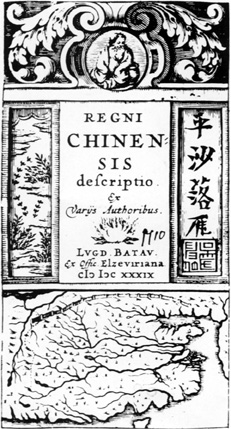
Regni Chinensis Descriptio (A Description of the Chinese Kingdoms) (Batavia, 1639). The oldest printed work in the National Library, Leal Senado.
THE HISTORICAL ARCHIVES OF MACAU
In the middle of February, 1979, the Historical Archives of Macau were set up. They were temporarily installed in Sir Robert Ho Tung's former residence.
The first collection of documents was given by the Civil Administration Department. Before 1980 further documents had arrived from the Santa Casa da Misericórdia, the Navy, the Leal Senado, the Treasury, the Town Council and the Security Forces.
At that time the archives were in such a state of disarray that it was necessary for Professor Silva Rego to come from Portugal. With the help of Dra. Beatriz Basto da Silva, a secondary school teacher and a well-known researcher on the history of Macau, he set to work. When Professor Silva Rego returned to Portugal at the end of 1980, the lack of auxiliary and specialised employees who could faithfully carry on his work was noted and, after searching for someone who could take on the job of Director of the Archives, Dra. Beatriz Basto da Silva was appointed. In 1982 the Educational Department sent Dra. Beatriz Basto da Silva to the First International Conference on Asian Archives held in Kuala Lumpur. International contacts were established, enabling a greater exchange of information between the participants. The interest in attending the conference expressed by the Archives of Macau was due to the fact that they wished to become members of the International Archives Council (IAC). This was to happen in the following year, 1983. The IAC offers its members the advantages of international contacts, up-to-date technical information and exchange of information.
On the 10th of March, 1982, the Historical Archives moved to a new building on the Avenida Conselheiro Ferreira de Almeida. At the beginning of 1986 the Archives came under the control of the Cultural Institute of Macau. Its doors were closed for renovation work and at present it is temporarily located on Avenida Horta e Costa.
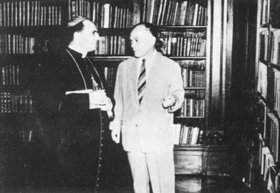
Luís Gonzaga Gomes receives Monsignor Capri in the National Library, Leal Senado, of which he was the Director.
a) Bulletin of the Historical Archives of Macau
Professor Silva Rego, assisted by Dra. Beatriz Basto da Silva, began the work of ordering and making a catalogue of all the existing documents which he found when he arrived in the Territory. The logical result of this work was the publication of the Bulletin of the Historical Archives.
This is a half-yearly publication with the primary objective of publishing the work of the Archives. Each edition has between two hundred and two hundred and fifty pages with a section on research where the work of eminent researchers will eventually be published. The first edition has articles by Charles Boxer, Father Benjamin Videira Pires and Xe Fuya (translated by Dr. José Graça de Abreu). By publishing the catalogues of the different sections of the Archives, the Bulletin informs those interested in the history of Portugal in the East of the documental resources which it possesses.
b) The Library of the Historical Archives
The Historical Archives have a specialised library which belonged to Luís Gonzaga Gomes. This library is available, primarily, for researchers who are carrying out studies in the Archives. Its stock is divided into the following sections: I -Macau; II - China; III - General History; IV - Art; V - Literature; VI - Various.
There are valuable editions in the library of which two, both from the 16th century, are worth mentioning. The first was printed in 1568 and is titled Nuovi Avisi dell'Indie di Portugallo, recevuti dalli Reverendi Padri della Compagnia di Giesu, tradotti della lingua Spagnuola nell'Italiana... (News of Portuguese India, written by Fathers of the Society of Jesus, translated from Spanish into Italian...). The second book was printed in 1589 and is titled Le Historie delle Indie Orientali, del R. P. Giovani Pietro Maffei della Compagnia de Giesu... (History of East India by Father Giovani Pietro Maffei, Society of Jesus). These 16th century books would be a valuable asset in any library.
From the 17th century there is a book by Father Nicolao Trigauci, Entrata nella China de'Padri della Compagnia del Gesu (Journey into China by Fathers of the Society of Jesus) which is a valuable source of information on the first missionary work in China with comments by the famous Jesuit missionary, Father Mateus Ricci.
In addition to monographs of great bibliographic value there is a copy of the oldest periodical of Macau, the newspaper "A Abelha da China", from the 3rd of October, 1822. The first issue was published on the 12th of September of the same year in a climate of intense political agitation, the result of friction between liberals and absolutists. "A Abelha da China" was a weekly of four pages, printed on China paper. Its editor was the prior of the Dominican order in Macau, Brother António de S. Gonçalo de Amarante, spokesman for the constitutionalists. There was a complete collection in the Clube Militar de Macau but it has disappeared and, at present, there is no collection in the Territory.
The bound copies of the Government Bulletins of Macau, Timor and Solor from the year 1850 are an important example of legislative documents.
c) The Historical Film Library of Macau
The Historical Archives of Macau also have a Film Library, created by Professor Silva Rego with a budget of twenty thousand Patacas. Its objective is to obtain historical documentaries relating to the Portuguese expansion in the East which are, at present, spread over several foreign archives. The Film Library of the Historical Archives of Macau will enable researchers and experts to gain access to a great deal of important documentation necessary to understanding the local history without having to go to Portugal, England or France. From 1980 to 1985 several hundred documentary films were copied from the Overseas Historical Archives in Lisbon. There are many documentary films on Macau in the Ajuda Library, the National Library, the libraries of Évora, Porto, Braga, London, Paris, etc., which are waiting for the same treatment.
Translated by João Libano
NOTES
(1) Died in Macau in January, 1606.
(2) Fróis, Luís, Fr.: "Tratado dos Embaixadores que foram a Roma no anno de 1582", in Pinto, J. A. Abranches et al: La Première Ambassade de Japon en Europe, Tokyo, 1942. Figueiredo, J. A.: "Primeira Embaixada do Japão à Europa.", Archivo Pittoresco, vol V, ed. Castro Irmão & Co., Lisbon, 1862.
(3) Braga, Jack M.: Primórdios da Imprensa em Macau, ed. Boletim Eclesiástico da Diocese, Macau, 1965, p. 6.
(4) Rodelles, Gomes, Fr.: Imprensa de los Antiguos Jesuitas en Europa, América y Filipinas durante los Siglos XVI al XVII, Madrid, 1910, pp. 29-30.
(5) The first edition was produced in Salamanca in 1565.
(6) Freitas, João de: "A Imprensa de Tipos Móveis em Macau." Anais das Bibliotecas e Arquivos de Portugal, 1915, from p. 211.
Peixoto, Jorge: "Notas" in McMurtrie, Douglas, C.: O Livro: Impressão e Fabrico, ed. Calouste Gulbenkian Foundation, Lisbon, 1969, pp. 405 -407.
(7) Arquivos de Macau, 2nd series, p. 100.
(8) Braga, Jack M.: ob, cit., p. 15.
(9) Boxer, C. R.: The Christian Century in Japan, Berkeley, p.134.
(10) Domingos, M. G. dos Santos: "Macau - Primeira Universidade Ocidental do Extremo Oriente", Anais da Academia Portuguesa da História, 2nd series, vol II, p. 206.
(11) Ljungstedt, Andrew: Historical Sketch of Portuguese Settlements, Boston, 1836, p. 40.
(12) In Os Militares em Macau, ed. CTIM, 1975, p. 469.
(13) Id., p. 466.
(14) Id., p. 467.
(15) Boletim da Província de Macau e Timor, Macau, 19th series, vol LIII, 1873.
(16) In Os Militares em Macau, ed. CTIM, p. 469.
(17) The secondary school had opened in the previous year, 1894.
(18) Boletim Oficial: Suplemento, Macau, no. 5, 1900, p. 64.
(19) Anuário de Macau, Macau, 1962, p. 27.
(20) Anuário de Macau, Macau, 1964, p. 31.
(21) Almeida, Justino Mendes de: "Discurso de Encerramento do Segundo Encontro de Bibliotecários e Arquivistas Portugueses", Relatório da Biblioteca Nacional de Macau, Macau, 1966.
(22)Macau Macau, no. 1, Jan.-Mar., 1981, pp. 15-18.
(23)The furniture of the "salas joaninas" in the National Library of Macau was commissioned in 1940 from the firm of Lane Crawford in Hong Kong. It was made of teak.
(24) Ordered to be completed in 1725, during the reign of D. João V.
*Graduate in History; specialist in Documental Sciences; Director of the National Library of Macau
start p. 25
end p.